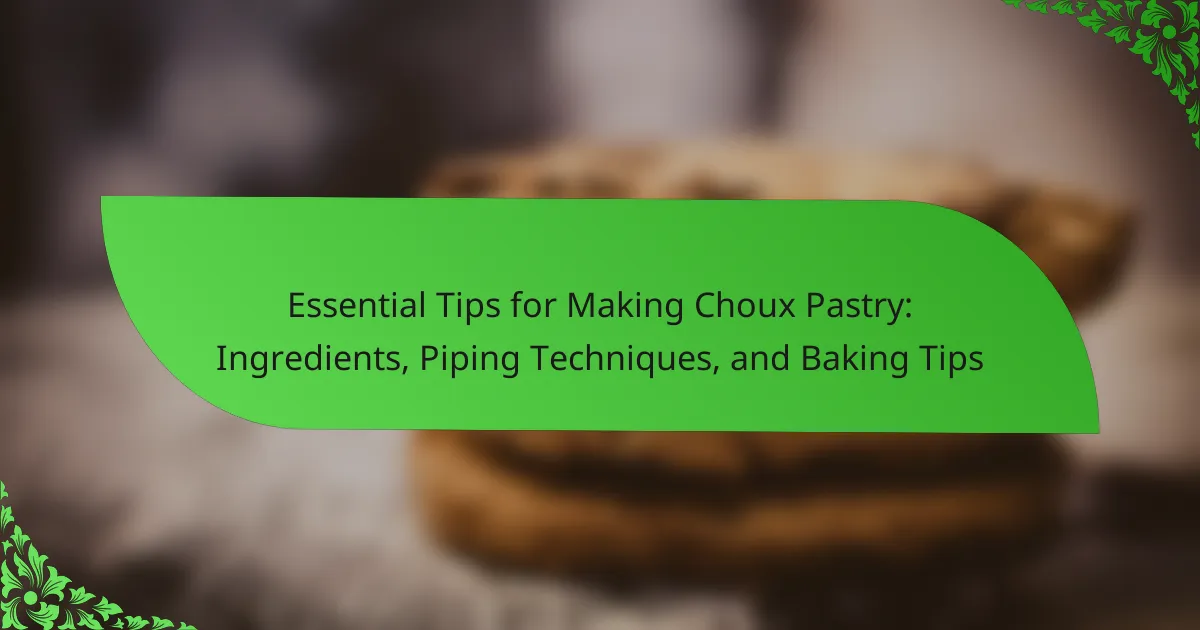Choux pastry is a light and airy pastry made from water, butter, flour, and eggs, known for its unique cooking method that involves both stovetop preparation and baking. This article provides essential tips for making choux pastry, including key ingredients, effective piping techniques, and critical baking advice to achieve optimal texture and rise. It explores the versatility of choux pastry, highlighting its use in both sweet desserts like éclairs and cream puffs, as well as savory options such as gougères. Detailed instructions on baking temperatures and methods ensure successful results, making choux pastry a staple in various culinary applications.

What is Choux Pastry?
Choux pastry is a light, airy pastry made from a mixture of water, butter, flour, and eggs. It is unique because it is cooked twice: first on the stovetop and then baked. This cooking method creates steam, which causes the pastry to puff up. Choux pastry is the base for many desserts, such as éclairs and cream puffs. Its versatility allows for both sweet and savory applications. The dough is often piped into various shapes before baking. Once baked, it has a hollow center, perfect for filling. Choux pastry has been a staple in French cuisine since the 16th century.
How is Choux Pastry different from other types of pastry?
Choux pastry is different from other types of pastry because it is made from a unique combination of water, butter, flour, and eggs. This mixture is cooked on the stovetop before baking, creating a light and airy texture. Unlike traditional pastries that use a solid fat, choux relies on steam generated during baking to puff up. The high moisture content in choux pastry leads to a hollow center, ideal for fillings. Other pastries, such as puff pastry, use layers of fat and dough to create flakiness. Choux pastry is often used for éclairs and cream puffs, showcasing its versatility. Its distinct preparation method sets it apart from other pastry types.
What are the key characteristics of Choux Pastry?
Choux pastry is a light, airy dough made from butter, water, flour, and eggs. It has a unique ability to puff up during baking, creating hollow centers. The high moisture content causes steam to form, which expands the pastry. Choux pastry is versatile and can be used for both sweet and savory dishes. Common examples include éclairs and cream puffs. It is typically baked at a high temperature to achieve the desired rise and crispness. The dough can be piped into various shapes before baking. Proper technique is crucial for achieving the perfect texture and structure.
Why is Choux Pastry considered versatile in baking?
Choux pastry is considered versatile in baking due to its ability to be used in various forms and applications. It can be piped into different shapes, such as éclairs, cream puffs, and profiteroles. This flexibility allows for a wide range of fillings, both sweet and savory. Choux pastry can also be baked, fried, or even frozen for later use. It has a unique ability to puff up when baked, creating a light and airy texture. The neutral flavor of choux pastry allows it to complement various ingredients. Additionally, it can be adapted for different cuisines and recipes. This adaptability makes choux pastry a staple in both professional and home kitchens.
What are the essential ingredients for making Choux Pastry?
The essential ingredients for making choux pastry are water, butter, flour, and eggs. Water is used to create steam during baking, which helps the pastry rise. Butter adds richness and flavor while also contributing to the pastry’s structure. Flour provides the necessary starches that form the dough. Eggs are crucial as they create a light texture and help bind the ingredients together. These ingredients work in harmony to produce the characteristic airy and crisp texture of choux pastry.
How does each ingredient contribute to the final product?
Flour provides structure to choux pastry. It absorbs moisture and forms gluten when mixed. This gluten network supports the pastry during baking.
Water is essential for hydration. It helps dissolve the flour and activates gluten. Water also creates steam, which causes the pastry to puff up.
Butter adds richness and flavor. It contributes to the pastry’s tenderness. When melted, butter coats the flour, limiting gluten formation for a lighter texture.
Eggs are crucial for leavening. They provide moisture and create steam during baking. Eggs also add structure and stability to the final product.
Salt enhances flavor. It balances the richness of butter and eggs. Salt also strengthens the dough, contributing to its overall structure.
Each ingredient plays a vital role in achieving the desired texture and flavor of choux pastry. The combination of these elements results in a light, airy, and flavorful final product.
What are the best types of flour to use for Choux Pastry?
The best types of flour to use for choux pastry are all-purpose flour and pastry flour. All-purpose flour provides the necessary structure and elasticity. It has a moderate protein content, typically around 10-12%. This allows for the right balance of strength and tenderness in the pastry. Pastry flour has a lower protein content, around 8-10%. This results in a more delicate texture, which some bakers prefer for lighter choux pastry. Both flours can produce excellent results, depending on the desired texture and final product.
What techniques are important for piping Choux Pastry?
The important techniques for piping Choux Pastry include using a proper piping bag and nozzle. A large round tip is typically recommended for even shapes. Consistent pressure while piping helps maintain uniform size and shape. Piping from a height allows for better control and shaping. Additionally, ensuring the pastry is the right consistency is crucial; it should be smooth and glossy. Using a template can aid in achieving uniform sizes. Finally, practice is essential for mastering the technique, as it enhances skill and confidence.
How do you choose the right piping tip for Choux Pastry?
To choose the right piping tip for choux pastry, select a tip based on the desired shape and size. Common choices include round tips for éclairs and star tips for cream puffs. Round tips create a smooth finish, while star tips add texture. The size of the tip affects the volume of pastry produced. Larger tips yield bigger choux, while smaller tips create delicate pastries. Consider the filling type as well; for thicker fillings, a wider tip is beneficial. Always test the piping tip with a small amount of dough to ensure it meets your expectations.
What are the best practices for piping Choux Pastry shapes?
The best practices for piping Choux Pastry shapes include using a proper piping bag and nozzle. A large star nozzle creates beautiful shapes. Ensure the pastry dough is smooth and not too runny. Hold the piping bag at a 90-degree angle to the baking sheet. Apply consistent pressure while piping to maintain shape. Release pressure before lifting the nozzle to avoid peaks. Use a wet finger to smooth any tips if necessary. Bake immediately for optimal puffing. These techniques help achieve uniform and aesthetically pleasing Choux Pastry shapes.
What common mistakes should be avoided when making Choux Pastry?
Common mistakes to avoid when making choux pastry include not drying the dough sufficiently. Insufficient drying can lead to weak structure and poor rise. Another mistake is adding eggs too quickly. Gradually incorporating eggs ensures proper emulsification and consistency. Failing to preheat the oven is also critical. A properly preheated oven helps achieve the desired puffiness. Additionally, opening the oven door during baking can cause the pastry to collapse. Maintaining a stable temperature is essential for successful choux pastry. Lastly, using the wrong flour can impact texture. All-purpose flour is recommended for optimal results.
How can you troubleshoot common issues in Choux Pastry preparation?
To troubleshoot common issues in Choux Pastry preparation, identify specific problems and their solutions. If the pastry doesn’t rise, ensure the dough is cooked sufficiently before adding eggs. Insufficient cooking can lead to excess moisture. If the pastry is too dense, check the egg incorporation process. Adding eggs gradually helps achieve the right consistency. If the pastry is too wet, reduce the liquid in the recipe. This adjustment can improve texture. For a hollow center, ensure the oven temperature is appropriate. A too-low temperature can prevent proper puffing. If the pastry deflates, avoid opening the oven door during baking. This can cause a sudden temperature drop. Each of these troubleshooting steps is based on common baking practices and experiences shared by professional pastry chefs.
What tips can ensure a successful rise in Choux Pastry?
To ensure a successful rise in choux pastry, maintain the correct water-to-flour ratio. Use equal parts water and butter by weight to create an ideal dough. Incorporate flour gradually while stirring to avoid lumps. Cook the dough until it forms a ball and pulls away from the pan. Allow the dough to cool slightly before adding eggs. Add eggs one at a time, ensuring each is fully incorporated before adding the next. Pipe the dough onto a baking sheet with space between each piece. Bake in a preheated oven at a high temperature initially, then reduce for even cooking. This method creates steam, which is essential for the rise.

How do you bake Choux Pastry effectively?
To bake choux pastry effectively, start by preheating the oven to 400°F (200°C). This temperature ensures proper rising during baking. Next, pipe the choux dough onto a baking sheet lined with parchment paper. Maintain space between each piece to allow for expansion. Bake the pastry for 25 to 30 minutes without opening the oven door. This prevents steam from escaping, which is crucial for achieving a light and airy texture. After baking, turn off the oven and leave the pastries inside for an additional 10 minutes. This helps them dry out and maintain their shape. Finally, cool the pastries on a wire rack before filling. Following these steps leads to successful choux pastry with a perfect rise and texture.
What temperature and baking time are ideal for Choux Pastry?
The ideal temperature for baking choux pastry is 425°F (220°C). The baking time typically ranges from 25 to 30 minutes. At this temperature, the pastry will rise properly and develop a golden-brown color. It’s crucial not to open the oven door during the first 20 minutes to ensure proper puffing. This method allows for the steam to build up inside the pastry, which is essential for achieving the desired texture. Proper adherence to these temperature and time guidelines results in light and airy choux pastry.
How does oven temperature affect the texture of Choux Pastry?
Oven temperature significantly affects the texture of choux pastry. Higher temperatures create steam quickly, leading to a lighter and puffier texture. Ideal baking temperatures range from 375°F to 425°F (190°C to 220°C). At these temperatures, the outer layer sets while the inside remains moist. Lower temperatures can result in denser pastries with less rise. Insufficient heat may cause the pastry to collapse as it cools. Proper oven temperature ensures even cooking and prevents sogginess. This is crucial for achieving the desired airy consistency in choux pastry.
What techniques enhance the baking process of Choux Pastry?
To enhance the baking process of choux pastry, several techniques can be employed. First, ensuring proper hydration of the dough is crucial. This involves using the right amount of water to create steam during baking. Second, preheating the oven to a high temperature, typically around 425°F (220°C), helps achieve a good rise.
Third, introducing steam into the oven during the initial baking phase promotes expansion. This can be done by placing a pan of water at the bottom of the oven. Fourth, avoiding opening the oven door during baking prevents temperature fluctuations that can collapse the pastry.
Finally, allowing the pastries to cool in the oven with the door ajar helps maintain their structure. These techniques collectively contribute to achieving light and airy choux pastry.
How can steam be used to improve the rise of Choux Pastry?
Steam can be used to improve the rise of Choux Pastry by creating a moist environment in the oven. This moisture helps to expand the dough as it heats. As the water in the dough turns to steam, it pushes against the structure of the pastry. This results in a lighter and airier texture. The initial burst of steam during baking is crucial for achieving maximum rise. Additionally, steam prevents the outside of the pastry from setting too quickly. This allows for proper expansion before the outer layer hardens. The combination of moisture and heat is essential for optimal choux pastry development.
What is the role of egg wash in baking Choux Pastry?
Egg wash serves to enhance the appearance and texture of baked Choux pastry. It creates a golden-brown color on the surface during baking. The proteins in the egg wash promote browning through the Maillard reaction. This reaction occurs when heat is applied, leading to a desirable crust. Additionally, egg wash can help in the adhesion of toppings or seeds. It provides a glossy finish that improves visual appeal. The use of egg wash is a common technique in professional baking. This practice ensures that the final product looks more appetizing and well-crafted.

What are some creative uses for Choux Pastry?
Choux pastry can be used creatively in various culinary applications. It serves as the base for éclairs, filled with cream or custard. Profiteroles, another popular use, are choux balls often filled with ice cream. Choux pastry can also be shaped into savory gougères, which are cheese puffs. Additionally, it can be piped into rings to create a delicate Paris-Brest dessert. Choux pastry is versatile enough to be used in soups, such as a garnish for cream soups. In some cultures, it is used to make churros, which are deep-fried and coated in sugar. These diverse applications showcase the adaptability of choux pastry in both sweet and savory dishes.
What are popular desserts made with Choux Pastry?
Popular desserts made with choux pastry include éclairs, cream puffs, and profiteroles. Éclairs are elongated pastries filled with cream and topped with chocolate. Cream puffs are round, airy pastries filled with whipped cream or custard. Profiteroles are similar to cream puffs but are often filled with ice cream and drizzled with chocolate sauce. These desserts showcase the versatility of choux pastry in creating both sweet and creamy textures. Their popularity is evident in various pastry shops and bakeries worldwide.
How can Choux Pastry be filled or topped for different recipes?
Choux pastry can be filled or topped in various ways for different recipes. Common fillings include pastry cream, whipped cream, and custard. These can be flavored with vanilla, chocolate, or coffee. Savory options include cheese, mushroom, or spinach mixtures. Toppings often consist of chocolate glaze, fondant, or powdered sugar. Each filling or topping enhances the overall flavor and presentation. For instance, éclairs are typically filled with pastry cream and topped with chocolate glaze. Profiteroles can be filled with ice cream and drizzled with chocolate sauce. The versatility of choux pastry allows for endless creative possibilities in both sweet and savory dishes.
What are some tips for perfecting your Choux Pastry skills?
To perfect your Choux Pastry skills, ensure precise measurements of ingredients. Accurate ratios of flour, water, and butter are crucial for the right consistency. Heat the mixture until it forms a cohesive ball, which indicates proper cooking. Gradually incorporate eggs, mixing thoroughly to achieve a smooth batter. Pipe the pastry onto a baking sheet with even spacing for uniform baking. Maintain oven temperature to allow for proper puffing; a preheated oven is essential. Avoid opening the oven door during baking to prevent collapse. Lastly, allow the pastries to cool completely before filling them to maintain structure.
How can practice improve your technique in making Choux Pastry?
Practice improves your technique in making Choux Pastry by enhancing your skill and consistency. Repeatedly making Choux allows you to understand the dough’s texture and behavior. You learn the right consistency for piping, which is crucial for achieving the desired shape. Each attempt helps you refine your timing for baking, crucial for proper puffing. Regular practice also builds muscle memory for piping techniques, leading to more precise results. Over time, you become adept at troubleshooting common issues, such as undercooking or overcooking. Mastery of Choux Pastry requires experience, which practice provides.
What resources are available for learning more about Choux Pastry?
Books, online courses, and cooking blogs are valuable resources for learning about Choux Pastry. Notable books include “Pastry School: 101 Techniques and Recipes” by Le Cordon Bleu. Online platforms like MasterClass offer courses taught by professional chefs. Websites such as Serious Eats provide detailed recipes and techniques. YouTube channels dedicated to baking often feature choux pastry tutorials. Community forums and social media groups can also provide tips and support. These resources collectively enhance understanding and skills in making Choux Pastry.
Choux pastry is a light and airy dough made from water, butter, flour, and eggs, distinguished by its unique cooking method that involves stovetop preparation followed by baking. This versatile pastry serves as the foundation for various desserts, including éclairs and cream puffs, and can be adapted for both sweet and savory dishes. The article provides essential tips for making choux pastry, covering key ingredients, effective piping techniques, and optimal baking practices to achieve the desired texture and rise. Additionally, it addresses common mistakes and troubleshooting methods to enhance the overall success of choux pastry preparation.
